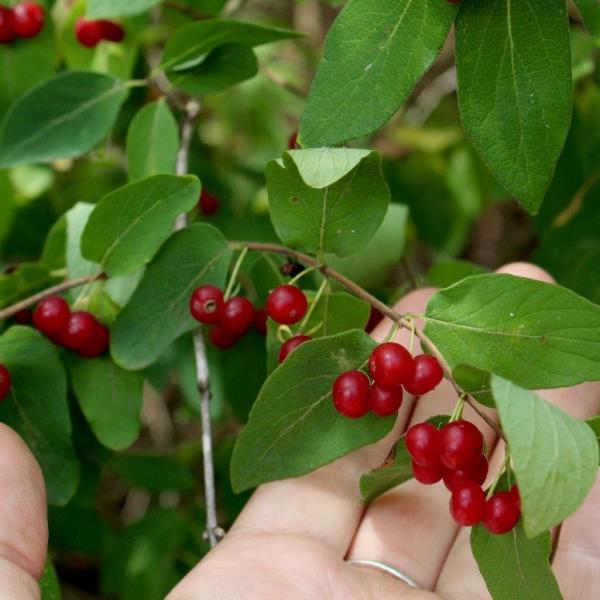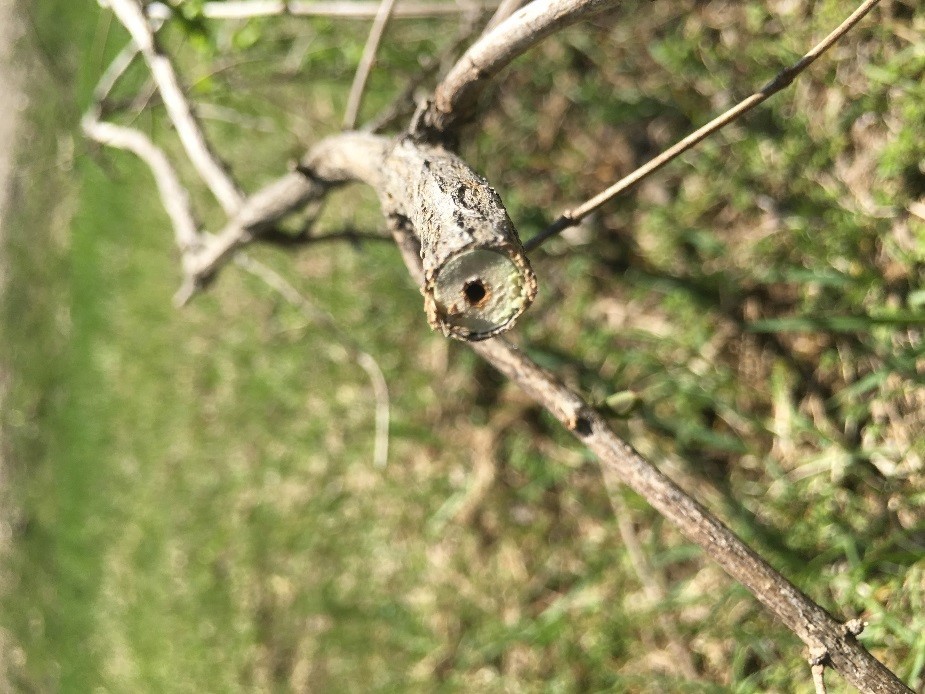
Winter walks through the woods can reveal many things to us—the tracks of our wildlife neighbors, the contours of the landscape, and with a practiced eye, the overwintering branches of woody understory plants like honeysuckle. In New England, there are present many members of the honeysuckle family (Caprifoliaceae), including native plants like American honeysuckle (Lonicera canadensis), and bush honeysuckle (Diervilla lonicera). However, several species of the genus Lonicera are considered invasive in Vermont, including Amur honeysuckle (L. maackii), Morrow’s honeysuckle (L. morrowii), Tatarian honeysuckle (L. tatarica), and Bell honeysuckle—a hybrid of Morrow’s and Tatarian—(Lonicera x bella). At right, fruit and leaves of an invasive honeysuckle.
These invasive honeysuckles were introduced from Europe and Asia in the 1800s, primarily as ornamental plantings. In the 1960s, invasive honeysuckles were also utilized for erosion control and wildlife cover, and remained in use for several decades before the full invasive nature of these plants was realized. Amur honeysuckle is rare in Vermont, and Morrow’s, Tatarian, and the hybrid Bell honeysuckle are more common across the state.
During the growing season, these perennial plants have green, oval shaped, oppositely arranged leaves. These shrub species can grow from 6-20’ in height. Flower color ranges by species, Morrow’s has white to yellow flowers, Tatarian has pink, red or yellow flowers, and Amur has purple, white or yellow flowers. The flowers turn to twinned fruits in the fall that are orange to red.
Both of Vermont’s native honeysuckles are widely distributed across the state, and at a quick glance, offer similar characteristics as the invasive honeysuckles. Regardless of the time of year, there is a consistent way to differentiate invasive shrub honeysuckles from Vermont’s native honeysuckles. Break off a branch of older growth (indicated by the shaggy, brown-grey bark) to observe the center of the stem (pith). The native honeysuckles have a solid white pith, whereas all the invasive shrub honeysuckles have brown, hollow piths.
Other distinguishing features to differentiate native from invasive include looking at the leaves --- those of the bush-honeysuckle have a serrated leaf edge while the invasives’ have a smooth edge; American honeysuckle leaves have a smooth texture and the growth form is much smaller and less dense. Some other plants that may be confused for invasive honeysuckles include common snowberry, border privet (also invasive), and dogwoods (red-osier, silky, grey). These plants all have oppositely arranged leaves and can be found in the understory of Vermont woods.
All four of the invasive honeysuckles are listed on Vermont’s Noxious Weed Quarantine, as Class B Noxious Weeds. This ranking means that these plants are not native to the state, are present in the state, and pose a serious threat to the state.
The strongest negative impact from these invasive shrubs are their tendency to form dense stands that exclude native forest understory plants, with rippling effects-- reducing food sources for wildlife, replacing safe habitat for nesting birds, and some research is suggesting dense infestations can even be a haven for pests like ticks.
To learn more about all the honeysuckles found in Vermont, check out these additional resources:
Native
Invasive
- Click below to learn about:
- Amur honeysuckle
- Morrow's honeysuckle
- Tartarian honeysuckle
- Shrub honeysuckles (collective)
- Bush honeysuckle (collective)

Hollow/brown pith of invasive honeysuckles.
Photo Credit: E. Spinney, VT FPR